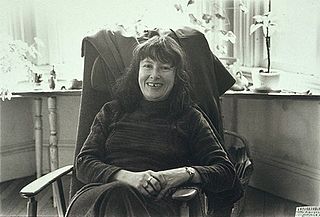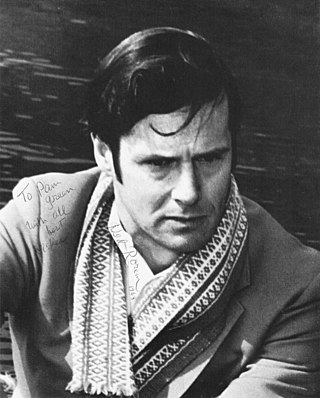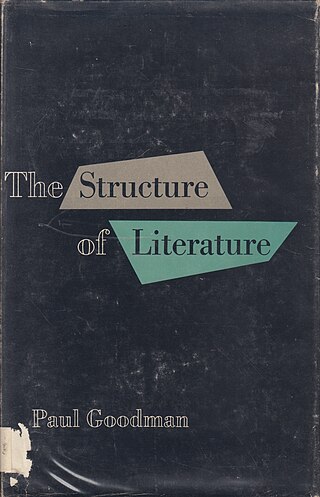
The Lordly Hudson is a poem and 1962 book of collected poetry by Paul Goodman.

The Lordly Hudson is a poem and 1962 book of collected poetry by Paul Goodman.
| External image | |
|---|---|

Richard Kostelanetz wrote that Goodman's title lyric was the most memorable line of "The Lordly Hudson": [1]
This is our Lordly Hudson hardly flowing
under the green-grown cliffs
and has no peer in Europe or the East.
Be quiet, heart! Home! Home!
Goodman wrote the poem in February 1937 in reference to his Manhattan homecoming. He was returning by bus during a break from his second semester at the University of Chicago, [2] where he had been unhappy. [3] The text reflects a "passionate pride in home (Manhattan) and a patriotic elation in things familiar". [4] "The Lordly Hudson" was titled "Poem" when published in Five Young American Poets, Second Series (1941). [5] The phrase "lordly Hudson" had been first penned by Washington Irving in the early 1800s. [6]
The repetition within the poem serves to emphasize the extent of the literal river's beauty. Goodman often uses "my" in his poems not as posssession but to describe something to which he has given himself. In this case, "our lordly Hudson" is an elevated version of "my" and the lonely joy the speaker wishes to share. [7]
It became Goodman's most famous poem. [8] [9] [10] American essayist Emile Capouya called "The Lordly Hudson" the greatest New York poem since Walt Whitman. The poem, wrote Capouya, represents Goodman's direct, unsophisticated rhetorical style, which pulls from staid virtues like patriotism. [11] Hayden Carruth wrote of its authentic feeling and unrivaled "simple expressiveness". [12] To critic Kingsley Widmer, Goodman's eccentric mannerisms overshadowed its emphasis on the Hudson as a place or experience. Widmer considered "The Lordly Hudson" to represent the inadequacies of Goodman's poetic expression, citing issues like the poem's "Lordly" repetition being awkward, archaic, and stiff. [13] Poet Judson Jerome laughed aloud reading the title lyric for the first time and was surprised to realize that Goodman meant it seriously. [14] What made the poem great, said Gordon Burnside for the St. Louis Post-Dispatch , was Goodman's "patriotic love ... underneath its kidding and fooling". [8]
Goodman continually revised his poems [15] and edited "The Lordly Hudson" in the weeks before his death in 1972 on his return home from teaching in Hawaii. The edited version, with some word and punctuation substitutions, appears in Goodman's posthumous Collected Poems . Hayden Carruth wrote that these substitutions were made hastily and cheapened Goodman's great poem into ordinariness for lessening the effect of the original poem's repetitions, formal expressiveness, and universality. [16] Kingsley Widmer described Goodman's change from "Be quiet, heart!" to the more personal variation, "Be patient, Paul!" as frivolous. [17]
| External audio | |
|---|---|

Composer Ned Rorem put Goodman's poem "The Lordly Hudson" to art song. [18] Rorem first met Goodman in 1938 at a weekly poetry reading in Chicago, when Rorem was an early teenager. Goodman became Rorem's foremost social and poetic influence, [5] his "Manhattan Goethe". [19] Rorem said he had no background in American art songs before he wrote "The Lordly Hudson". He was inspired to set Goodman's poem to song after hearing Francis Poulenc's "C" setting of Louis Aragon, particularly the vocal interval "de la prairie", at a New York Christmas party in 1946. Though he had struggled to set the poem to music before, Rorem wrote the song in one session the next day, beginning with the "Home! Home!" and "No, no!" parts. [5] The result is lyrical and dramatic, with arching, high emotion intervals and "supple melodic phrases" recalling the Hudson River's grandeur atop a "strong rhythmic chordal accompaniment". [4] A Singer's Guide to the American Art Song described Rorem's composition as matching the urgency and nobility in Goodman's original poem. [20]
Soprano Janet Fairbank, who was known for new American songs, premiered the work without changes. It was known then as "Poem" and later became "Driver, What Stream Is It?" before Goodman titled it "The Lordly Hudson" for the song's publication by Richard Dana. Fairbank died on the day of its publication in 1947. The song was dedicated to her. [5]
The Music Library Association recognized Rorem's "The Lordly Hudson" as the best published song of 1948. [18] It launched his career [21] [22] as his first song, [23] becoming one of his best-known and most-sung. [24] [4] Rorem would continue to set poetry by Goodman to song throughout his career. [25] [26] [4] [27] Vocalists Susan Graham [28] [29] and Nathan Gunn have recorded performances of "The Lordly Hudson". [30] [31] The song became a cultural touchstone of New York City. [32]
| Author | Paul Goodman |
|---|---|
| Publisher | Macmillan |
Publication date | 1962 |
The Lordly Hudson: Collected Poems is divided into seven sections: Short Poems, Longer Poems, Stories, Sonnets, Ballades, Love Poems, and Sentences and Prayers. [33] The collection includes Goodman's poetry from 1940 to 1962, written in a traditional structure with less traditional content. The poetry is personal in nature, covering Goodman's aging, independence, love, and sexual potency. [34] The collection features many poetic forms. [35] The Lordly Hudson is Goodman's first poetry collection [36] [35] and his best known poetry book. [9]
The Macmillan Company published The Lordly Hudson: Collected Poems in October 1962, with a paperback to follow three months later. The manuscript is held in the Syracuse University special collections. [37] The collection's namesake poem is printed on its cover. [14] Goodman communicates that his intent is for the collection to embody an attitude rather than writing beautiful poems. [14] Several of the poems have gay themes. [38]
Poet Harvey Shapiro wrote that the poetry in The Lordly Hudson, Goodman's first solo collection, was "the purest version of his thought ... always serviceable, sometimes awkward ... by rips and starts brilliant." [1] Jerome, on the other hand, found the collection mired in "awkwardness, wordiness, and pointless toying" and that Goodman's attitude comes across in themes of "indiscriminate sexuality, ... admiration for power and shock, plainness and simple pleasures, and an ego throbbing like swollen flesh". [14]
Poet Denise Levertov considered Goodman's poems to be on par with his short stories, which she said were among America's greatest. [39] While she considered half of the book's poems to be exceptional, she deemed others exceptionally bad, yet considered Goodman's strength to be the total effect of his voice coming throughout the collection, rather than the quality of individual poems. [40] She found his story poems, however, to be unsuccessful, [33] and his "Red Jacket (Lake Seneca)" to be her favorite. [39]

Priscilla Denise Levertov was a British-born naturalised American poet. She was heavily influenced by the Black Mountain poets and by the political context of the Vietnam War, which she explored in her poetry book The Freeing of the Dust. She was a recipient of the Lannan Literary Award for Poetry.

Ned Miller Rorem was an American composer of contemporary classical music and a writer. Best known for his art songs, which number over 500, Rorem was considered the leading American of his time writing in the genre. Frequently described as a neoromantic composer, he showed limited interest in the emerging modernist aesthetic of his lifetime. As a writer, he kept—and later published—numerous diaries in which he spoke candidly of his exchanges and relationships with many cultural figures of America and France.

Hayden Carruth was an American poet, literary critic and anthologist. He taught at Syracuse University.
Nationality words link to articles with information on the nation's poetry or literature.

Growing Up Absurd is a 1960 book by Paul Goodman on the relationship between American juvenile delinquency and societal opportunities to fulfill natural needs. Contrary to the then-popular view that juvenile delinquents should be led to respect societal norms, Goodman argued that young American men were justified in their disaffection because their society lacked the preconditions for growing up, such as consideration and self-respect, meaningful work, honorable community, sexual freedom, and spiritual sustenance.

The Empire City is a 1959 epic novel by Paul Goodman.

Communitas: Means of Livelihood and Ways of Life is a 1947 book on community and city planning by Percival and Paul Goodman. Presented as an illustrated primer on how city planning affects socioeconomic order and citizens' empowerment to better their communities, the book reviews historical and modern approaches to urban planning before proposing three of the Goodmans' own provocative community paradigms.

Kafka's Prayer is a 1947 book-length analysis of the novelist Franz Kafka and his works by Paul Goodman. Using Freudian and Reichian psychoanalysis, Goodman assesses the philosophical and religious significance of Kafka's aphoristic statements and three novels. He levels an anarchist societal critique against social institutions borne from neuroticism. Goodman used the book, published by Vanguard Press, to grapple with the religious implications of psychoanalysis and transition from a career writing on Jewish concerns to a period that would culminate in his collaboration on the founding work of the gestalt therapy movement.

The May Pamphlet is a collection of six anarchist essays written and published by Paul Goodman in 1945. Goodman discusses the problems of living in a society that represses individual instinct through coercion. He suggests that individuals resist such conditions by reclaiming their natural instincts and initiative, and by "drawing the line", an ideological delineation beyond which an individual should refuse to conform or cooperate with social convention. While themes from The May Pamphlet—decentralization, peace, social psychology, youth liberation—would recur throughout his works, Goodman's later social criticism focused on practical applications rather than theoretical concerns.

Little Prayers and Finite Experience is a book of prose and poetry by Paul Goodman.

Collected Poems is a book of Paul Goodman's collected poetry, edited by his literary executor Taylor Stoehr and introduced by George Dennison.

Making Do is a 1963 novel written by Paul Goodman and published by Macmillan.

The Structure of Literature is a 1954 book of literary criticism by Paul Goodman, the published version of his doctoral dissertation in the humanities. The book proposes a mode of formal literary analysis that Goodman calls "inductive formal analysis": Goodman defines a formal structure within an isolated literary work, finds how parts of the work interact with each other to form a whole, and uses those definitions to study other works. Goodman analyzes multiple literary works as examples with close reading and genre discussion.

Paul Goodman described himself as a man of letters but foremost a poet. He published several poetry collections in his life, including The Lordly Hudson (1962), Hawkweed (1967), North Percy (1968), and Homespun of Oatmeal Gray (1970). His Collected Poems (1973) were published posthumously.
Paul Goodman's oeuvre spanned fiction, poetry, drama, social criticism, psychoanalytic theory, and literary analysis. While he viewed himself as a man of letters, he prized his stories and poems above his other work. To Goodman, writing was "his vice" or "way of being in the world".
Taylor Stoehr (1931–2013) was an American professor and author. He edited several volumes of Paul Goodman's work as his literary executor.

Parents' Day is a 1951 novel by Paul Goodman. Written as autobiographical fiction based on the author's experiences teaching at the upstate New York progressive boarding school Manumit during the 1943–1944 year, the book's narrator grapples with his homosexuality and explores a series of sexual attractions and relationships that culminates in his being fired by the school. Goodman wrote the novel as part of a Reichian self-analysis begun in 1946 to better understand his own life. He struggled to find a publisher and ultimately self-published through a friend's small press. Reviewers remarked on unease in Goodman's sexual revelations, lack of self-awareness, and lack of coherence in the text. Parents' Day sold poorly and has been largely forgotten, save for some recognition as an early gay American novel.
Prior to his career in social criticism, the American writer Paul Goodman had a prolific career in avant-garde literature, including some 18 works for the stage. His plays, mostly written in the 1940s, were typically experimental. Their professional productions were either unsuccessful or flopped, including the three productions staged with The Living Theatre in the 1950s and one with The American Place Theatre in 1966. His lack of recognition as a litterateur in the 1950s helped drive him to his successful career in social criticism in the 1960s.

Paul Goodman was an American writer and public intellectual best known for his 1960s works of social criticism. Goodman was prolific across numerous literary genres and non-fiction topics, including the arts, civil rights, decentralization, democracy, education, media, politics, psychology, technology, urban planning, and war. As a humanist and self-styled man of letters, his works often addressed a common theme of the individual citizen's duties in the larger society, and the responsibility to exercise autonomy, act creatively, and realize one's own human nature.

The Society I Live in Is Mine is a 1963 book of Paul Goodman's social commentary ephemera. In letters to the editor, essays, speeches, reviews, and other clippings, Goodman addresses the general public on a range of civic problems, both to influence their thinking and to model the type of alert and intervening citizen he believes is necessary for societal change. His proposals span from urban renewal to school administration, with a particular focus on education and youth, and reflect his community anarchist position in wanting to spur individual initiative, oppose supreme power, and experiment with social alternatives.